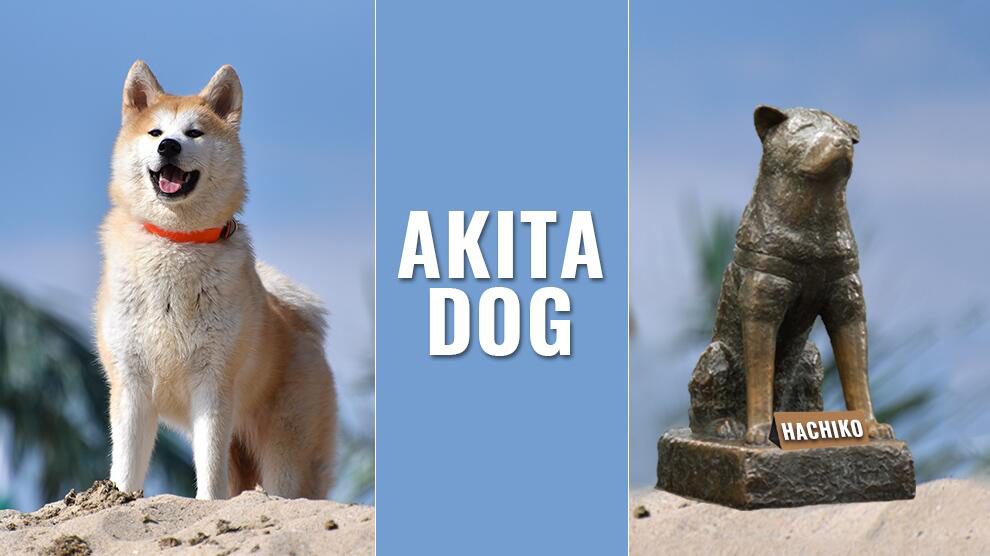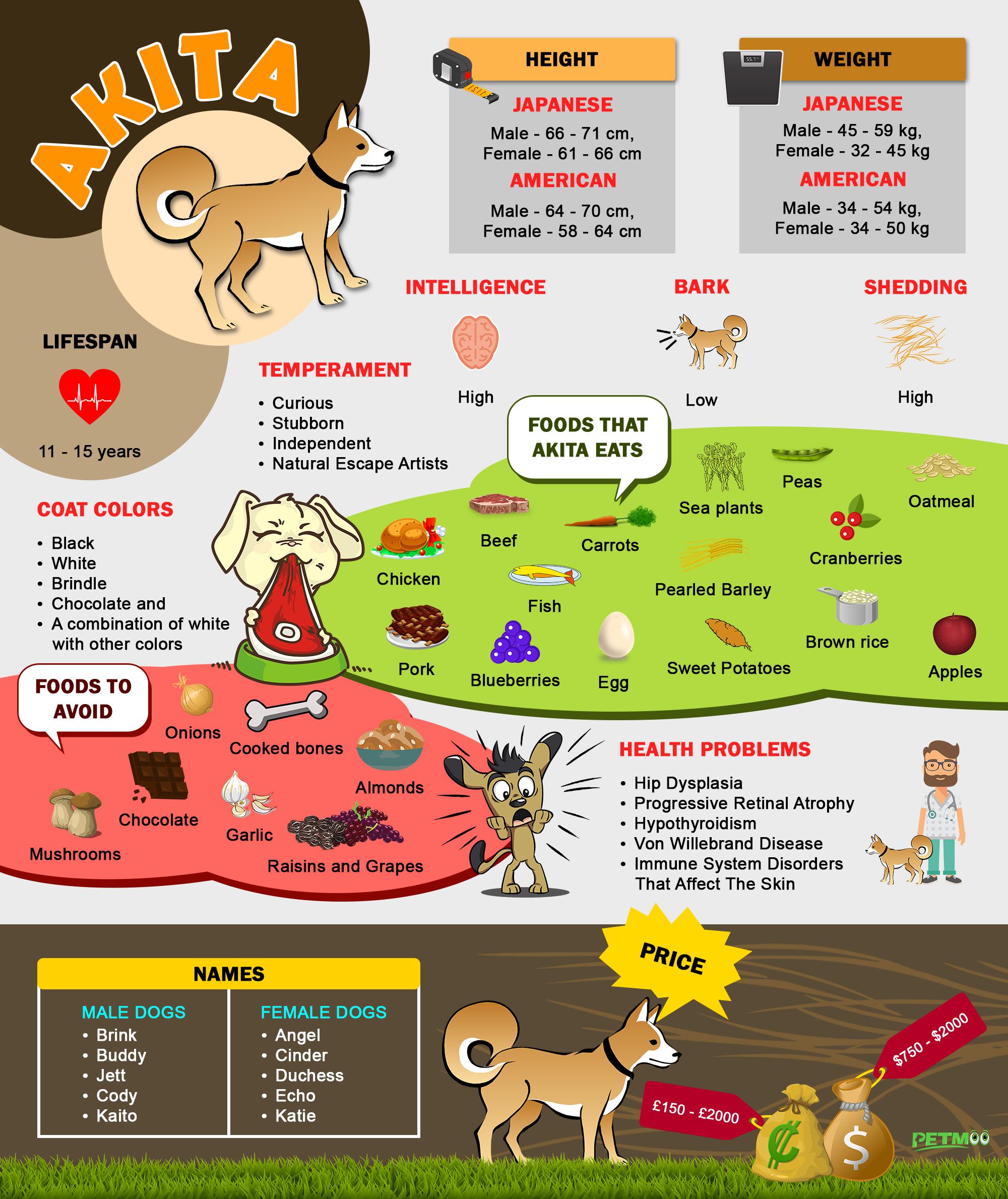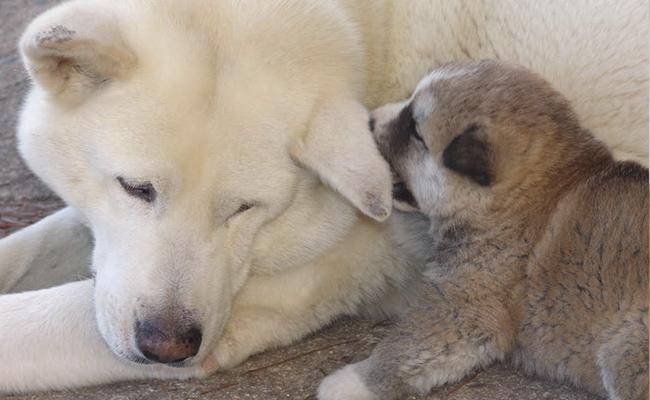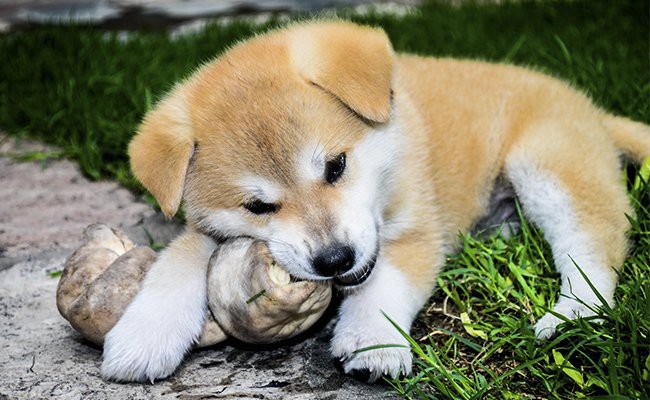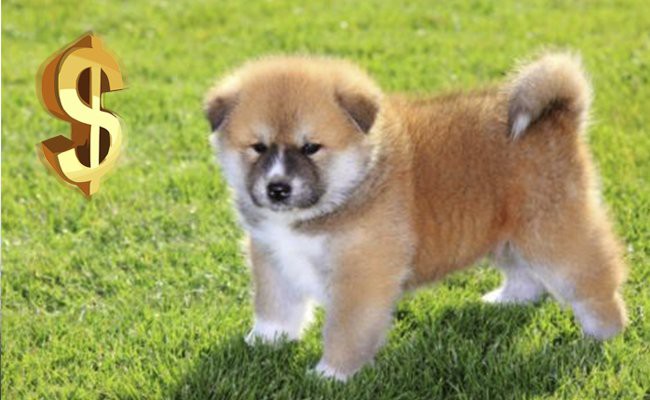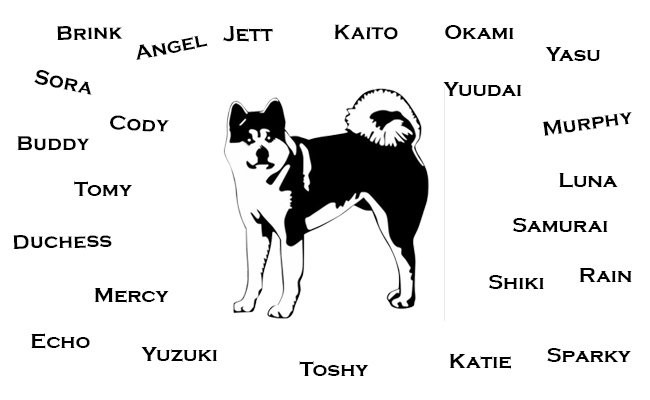- Video And Infographic
- Breed Characteristics Sheet at a Glance
- History Of Akita Dogs
- Coat Colors
- Inu Puppy
- Is Akita The Right Dog For You?
- Size
- What Kind Of Dog Is Akita?
- How To Take Care Of An Akita?
- Training
- Puppy Food
- Grooming And Shedding
- Health Problems
- How Much Do Akita Cost?
- Puppy Names
- Interesting Facts Of Akita Puppy
- Breeders
Dog Pregnancy Calculator And Timeline
Honored as the number one dog in Japan, the adorable Akita Inu dog has the great honor of being memorialized on a postage stamp.
It was an Akita dog in Japan that even after his master’s death proved his consistent loyalty by waiting for his master’s return in a railway station for 10 years.
Many celebrities openly declared their love for Japan’s Akita dogs. In recent years, many people around the globe celebrate their ownership of Japan’s most famous indigenous breeds.
If you’re looking for a dog that is devoted, courageous, and unwaveringly faithful to its owner, then this may be the perfect dog breed for you!
“If it’s not an Akita Inu, then it should be a dog!” –
This saying is rather a normal expression by those who fancy the breed.
Akita Breed Characteristics Sheet at a Glance
Origin: Japan
Size: Large
Dog Breed Group: Working Group
Purebred: Yes
Lifespan: 10-15 Years
Height: Male: 26-28 inches (66-71 cm), Female: 24-26 inches (61-66 cm)
Weight: 70-130 pounds (32-59 kg)
Coat Appearance: Thick double coat, harsh outer coat, and dense, soft undercoat
Coat Colors: White, brindle, or pinto with a mask
Temperament: Loyal, reserved, courageous, dignified
Good With Children: Yes, if raised with them, but best with supervision due to size and strength
Intelligence Level: High
Good With Pets: Can be aggressive with other dogs, especially of the same sex; socialization is critical
Hypoallergenic: No
Grooming: High; sheds heavily twice a year
Barking: Moderate; tends to be quiet but will alert when necessary
Suitable For Apartments: No, needs space and a securely fenced yard
Need For Exercise: Moderate; requires regular exercise but is not overly hyper
Easy To Train: Can be stubborn; requires consistent, firm training from an experienced owner
Good For First Time Owners: No, best for those familiar with large, dominant breeds
Health Issues: Hip dysplasia, progressive retinal atrophy, autoimmune thyroiditis, and other genetic conditions
Litter Size: 3-12 puppies
Average Price: $800 to $2,000 USD
Breed Overview: The Akita is a noble and imposing breed, originally used for guarding royalty and nobility in feudal Japan. This breed is known for its unwavering loyalty to its family, often referred to as being somewhat cat-like in temperament due to their cleanliness, careful grooming habits, and aloofness with strangers. Akitas are revered in their native country of Japan, and a statue of the famous Akita “Hachiko,” known for his remarkable loyalty, stands in Tokyo. Akitas require a dedicated owner who can handle their complex temperament and provide them with the training, socialization, and exercise they need to be well-adjusted pets. They are best suited to a home environment where they can be part of the family but may require careful introduction to other pets and children.
History Of Akita Dogs
Akita Inu is the largest of the ancient canine clan of Japanese spitz-type dogs. Originally, they emerged from the mountain areas of Akita Prefecture, Japan.
‘Kazuno-Inu’, ‘Odate-Inu’ and ‘Nambu-Inu’ were the different names given to this breed in their corresponding areas of northern Akita Province.
They were identified as the ‘Regional Dogs’ in the local language. ‘Kuriya-Inu’ or ‘Kuwae-Inu’ was the name given to these breeds in urban areas and were used for fighting. , These breeds from the countryside were known as ‘Matagi-Inu’.
Akitas were also used to retrieve waterfowl.
During the period of Tokugawa Tsunayoshi (1680-1709), the fifth shogun of Japan, the breed’s history took an amazing shift. He is a passionate dog lover and he declared the laws of Shorui Awaremi no Re (Law Prohibiting Cruelty to Animals )in 1687.
According to this law, anyone who harmed dogs could be imprisoned and dogs should be addressed in a highly polite manner.
The ordinary Akita Inu had become a samurai dog for Japanese royalty and aristocrats.
In 1919, the Japanese included this large spitz-type dog in a list of natural monuments to be preserved as it was on the verge of extinction with Japan’s constant involvement in world war I and II.
After WWII, American servicemen stationed in Japan saw the few charming Akitas that were left alive.
They got attracted to the massive-sized dog and the Akita became one of many “Japanese Souvenirs” brought to the US.
But, the first Akita dogs to come to America were the puppies called Kamikaze-go and Kenzan-go that were given to Helen Keller on her visit to Japan in 1937.
There are two main types of Akitas in America.
- Sturdy and Large American Akitas with a black marking
- Conventional and refined Japanese Akitas with the only approved colors being white, brindle, and red with white markings.
The AKC recognized the Japan Kennel Club in 1992. JKC registered Akitas from Japan were allowed to re-register with the AKC.
Akitas are used nowadays as police dogs, sled dogs, guard dogs, and therapy dogs. Many dogs are trained companions of hearing and visually impaired people.
Usually, they are eagle-eyed guardians of their families.
Akita Coat Colors
Akita has a double coat with a shorter top coat and a thick and lush undercoat. The coat of an Akita puppy appears in various colors such as:
- Black
- White
- Brindle
- Chocolate and
- A combination of white with other colors
Akita Inu Puppy
Japanese Akitas are large-sized and well-boned with well-developed muscles. The domineering pride of an Akita is plainly visible and its guts are equivalent to a Samurai warrior.
Male dogs’ ratio of height to body length is 10: 11. Female dogs are slightly longer in length. The height to the depth of chest ratio is 2 to 1.
American Akita puppies differ greatly in facial structure and are generally larger than the Akita Inu. They have a broad head (more bear-like face) and small deep-set eyes with more erect ears.
Strangely, every Akita’s tail curls up differently, so every Akita is unique!
Is Akita The Right Dog For You?
If you want a dog who…
- Is robust, strong, and with a wolf-like appearance
- Active, loyal, and lively but not a lapdog
- Moves with a dignified and decorous style
- Doesn’t need vigorous exercise requirements
- Doesn’t bark often – the “strong and silent” type
Good for you. You may get an Akita
If you don’t want to deal with…
- Potential aggression, suspiciousness toward people when not socialized properly
- Aggression toward other animals, dogs, and cats with strong chasing instincts
- Strong-willed mind of his own, requiring a confident owner who can take charge
- Heavy shedding
An Akita doesn’t look right for you.
Akita Size
Japanese Akita Height And Weight
Height – Male – 66-71 cm, Female – 61-66 cm
Weight – Male – 45-59 kg, Female – 32-45 kg
American Akita Height And Weight
Height – Male – 64-70 cm, Female – 58-64 cm
Weight – Male – 34-54 kg, Female – 34-50 kg
Akita Lifespan
The average life of an Akita puppy is between 11 and 15 years only if it is well maintained with a good diet and grown in a healthy environment.
What Kind Of Dog Is Akita?
Akita is a natural-born pack leader, known for its stubborn and independent temperament. Akita’s temperament may range from sociable and outgoing to more aloof towards strangers and only pleasant with its family.
This is not the best breed for families with toddlers and other pets. If you like to get an Akita as a family pet, it is best to get an Akita puppy so that the dog can be socialized early on and made comfortable with kids.
They are amazingly curious and clever dogs. They possess some odd cat-like traits so they are often called cat-dogs. Akitas are inquisitive, headstrong, and natural escape artists.
Who Gets Along With Akita Dogs?
- Those who seek a reliable guard dog
- Families with older kids
- Active household
- Those who want a very large dog to cuddle up with
- People that live in cold climates and enjoy outdoor activities.
- Farmhouses, country homes or houses with large fenced-in yards(at least 6-foot fence)
- Folks looking for hunting, camping or hiking companions.
Adaptability:
- Apartment living – No
- Good for first-time owners – No
- Sensitivity level – Average to high
- Loneliness – Yes
- Cold weather – High
- Hot weather – Low
Friendliness:
- With Family – High
- Kids – High
- Other dogs – Moderate, if raised together
- Cats – Moderate, if raised together
- Other pets – Moderate, if raised together
- Strangers – Suspicious, reserved
General Behavior:
- Independence – Independent
- Dominance – High
- Combativeness – Bit aggressive
- Indoors – Moderately active
- Outdoor – Highly active
- Territorial – Yes
- Easy of transportation – Medium
How To Take Care Of An Akita?
- Exercise needs – Fairly high
- Intensity – Medium
- Activity level – Medium
- Exercise requirements – >60 minutes/day
- walk mileage/ week – 8 miles
- Playfulness – High
- Grooming needs – High
- Tendency to Drool – No
- To Snore – No
- Bark – Low
- Dig – Low
- Social/Attention Needs – Low
So, what about the first-time owners?
Yep, they look like teddy bears but they’re not made of marshmallows.
Akita is not the best choice for first-time dog owners. They need to be trained, socialized, and handled by people who are proficient in handling dogs.
They are naturally bossy. So they need to be rightly handled and trained right from the outset. They demand enormous socialization training from a very early age to habituate the dog to tolerate its furry friends the best way possible.
They are real samurais! You should be consistent and keep your training sessions short and sweet. They are also so shrewd that if you make any harsh, inconsiderate corrections, they may stand firm and become even more resistant.
Akitas may be better for a first time owner in certain cases, for those who have time to devote to educate, socialize his dog and who feels the desire to learn, rather than someone experienced about other dog breeds and thinks that Akitas are also the same.
Obviously, First timers have to have grip and tact to manage them, but Akitas can be easily trained, especially when you are well prepared.
Akita Training
- Trainability – Quick learners but may be stubborn
- Intelligence – High
- Memory – High
- Mouthiness – Low
- Prey drive – High
- Wanderlust potential – High
Is an Akita hard to train?
The Akita Inu is not the easiest breed to train because of its independent nature. During the training, he is more likely to use his wits.
Despite the fact that he is an intelligent dog and motivated dog, he needs a firm and consistent trainer/ owner to inculcate proper canine codes.
If there is no proper training, owners may find it quite hard to handle him as he grows up.
There will be always a streak of stubbornness in them but you just need to be consistent and make sure to establish yourself as the pack leader.
For best results, it’s essential to work with a trainer who understands the breed’s independence, territorial nature, and possessiveness.
Start extensive socialization and basic obedience training with him from puppyhood and include a variety of dog toys and treats to retain your dog’s interest.
Getting outdoors for some action is also important to them as they need a good daily workout, whether a jog flanking his bicycling owner or it’s a walk in the neighborhood. They cannot be trusted off-leash as they are proficient escape-artist and have a strong prey drive.
Keep in mind; it’s essential that you start training at puppyhood. This can help shirk moments of inconsistent behavior. Akita puppies should be exposed to other dogs and pets early on so that no authority issues surface in the future.
Rules of Thumb in Positive Reinforcement
- Keep it short & uncomplicated
- Immediately reward/praise the desired behavior
- Every behavior has a price tag- the more difficult the demand higher should be the paycheck.
- Be patient and consistent
- Make learning fun for both you and your dog
Akita Puppy Food
Rough Feeding guide for Akita dog:
Meal frequency for Akita:
- Puppies first 1-3 months: three meals per day
- After the third month: two meals per day
Remember the formula = (Weight (Kgs) X 30) + 70 = Daily caloric intake.
For instance, a male Akita which weighs 20 kg, therefore would require: 30 X 20 kg +70 = 670 Calories per day
Dry dog food puppy feeding:
- Average = Daily cost $2.00 – $2.25
- Monthly cost $60.00 – $67.00
- Pups between (2-3 months) old – 3 meals every 24 hours (280g- 400g).
- 3 to 6 months old – 2 meals daily (400g- 620g)
- Feed puppies 6 months to 1 year – 2 bowls of food daily (600g-400g)- gradually reduce the feeding
- When your puppy is 15 months old, one or two smaller bowls/ 24 hours are typically all that’s necessary.
Remember, the feedings depend on your puppy’s build, eating affinities, and on their activity level.
Feeding guide for adult dogs:
- Dogs 35 kg =350g-450g
- 45 kg = 500g-600g
- 55 kg = 500g-600g
Here is the macronutrient breakdown for you to glance through.
- Protein content should be anything from 30%
- Carb content should be 30 to 65%
- Fiber content should be less than 4%
- Fat content should be less than 10%
- Calcium content should be 0.5 – 0.8%
- Phosphorous content should be 0.4 – 0.7%
- Sodium content should be 0.2 – 0.4%
Best food for Akitas- our picks
- Wellness Large Breed Complete Health Adult Deboned Chicken & Brown Rice Recipe
- Fromm Large Breed Adult Gold
- American Journey Chicken & Brown Rice Adult Dry Food
- NomNomNow Fresh Dog Food
- Canidae PURE Elements With Lamb Limited Ingredient Diet
- Now Fresh Large Breed Adult Dog Dry Food
- Taste Of The Wild High Prairie Dry Dog Food
- Ollie Healthy Turkey Feast Fresh Dog Food
- EVO Red Meat Formula Large Bites Dog Food
- Gary’s Best Breed Holistic Large Breed Dry Dog Food
Natural foods like rice and fish will be most suitable for Akita dogs because they are used to eating such kinds of foods.
Foods that Akita eats
- Chicken
- Fish
- Egg
- Sea plants
- Beef
- Pork
- Oatmeal
- Brown rice
- Pearled Barley
- Carrots
- Sweet Potatoes
- Peas
- Apples
- Blueberries
- Cranberries
Foods to avoid (Vet Recommended)
- Mushrooms
- Cooked bones
- Raisins and Grapes
- Chocolate
- Garlic
- Onions
- Almonds
Akita Grooming And Shedding
- Coat density – Normal to dense
- Length – Medium
- Texture – Straight
- Brushing frequency – Weekly twice
- Trimming/stripping – No
- Hypoallergenic – No
- Shedding – High
Top Rated Dog Trainers / Walkers / Breeders In Your Area
Akita Health Problems
Some major health problems affecting Akita:
1. Hip Dysplasia
Symptoms
- Limited movement
- The decreasing rate of activity
- Loosening of the hip joints
- Experiencing toughness in climbing and alighting (getting down) stairs
- Standing with legs placed closer to each other
- The rough sound made by the joints causing difficulty in free movement
- Bunny hop walking style
- Contraction of the hind leg muscles
- Considerable weight loss in the thighs (muscle mass)
- Formation of bulged shoulder muscles due to extra pressure applied to adjust the lameness in the hind leg
Causes
- Inherited (hereditary)
- Bad diet (Malnutrition)
- Excess body weight
- Exercising daily for a reasonably long time causing heavy strain to the hip joints
Treatment
Finally, after a thorough reading of the dog’s condition, the vet will advise for the correct treatment. Especially, if a vet opts for non-surgical methods to treat a dog, the treatment will be:
- Exercise-related recommendations given to the order to ensure that the dog does not put excess weight and strain the hips
- Medications like aspirin, corticosteroids and anti-inflammatory drugs
- Applying joint fluid modifiers
Surgical treatment
Total Hip replacement (THR) is the most common method of surgical treatment that is applied. Artificial hip in the forms of metal or plastics is instilled in the affected dog’s hip joint area.
The affected hip joint is removed and then the said process is carried out. The pain caused by hip dysplasia is cured by this method.
2. Progressive Retinal Atrophy
Symptoms
- Shows reluctance to move during the night time
- Delayed responsiveness of the pupils to light
- Avoids the daily activities of running and climbing and getting down the stairs
- Night blindness
The associated symptoms of night blindness which causes loss of vision for the dog results in:
- Accidentally bumping on the furniture, window frames, and other things
- Slipping and falling when the dog’s feet strikes some objects unintentionally
- The dog does not respond immediately even when very dangerous situations, for example, if fire accident or burglary happens in the house
Causes
Progressive retinal atrophy is a genetic disease by nature and so it cannot be cured. Of course, there are some useful steps can be taken for bettering the living conditions of the affected dog.
Treatment
As stated earlier, until now there is no treatment for curing progressive retinal atrophy in dogs. Furthermore, maintaining the same house environment will ensure that the dog does not face further difficulties.
- Place the food and water bowls in the same place where the dog used to take food and water
- Likewise, move the furniture just a few yards away and to a position near the window. Some small gates can be fixed for safety purpose. Therefore, these steps will help to reduce the risk of fall injury to the dog.
3. Hypothyroidism
Symptoms
- Depression
- Anxiety
- Head shaking
- Avoiding exercises
- Dryness in the skin
- Weight gain
- Loss of Hair
- High sensitivity to cold
- Anaemia
- Bradycardia (slow heartbeat)
- Ear infection
- Nail infection
- Seizures
Causes
- Autoimmune thyroiditis, which is a disease that affects the body’s immune system
- Problems in the Adrenal gland
- The side effects of medications like steroids
- Cancer of the thyroid gland
- Atrophy of the thyroid gland
- Avoiding exercises
Treatment
L-thyroxine is a synthetic hormone that is usually not able to be given to dogs with hypothyroidism. Doctors recommend thyroid glandular and cofactors like iodine and thyroxine to enable the stable production of thyroid hormones.
The medications are oral drugs, used for treating dogs with hypothyroidism and prescribed for daily intake.
4. Von Willebrand Disease
Symptoms
- Excessive bleeding after toenail clipping
- Enlargement of the scrotum (bruising)
- Bleeding in the intestine
- Bleeding in the joints
- Blood in the urine and stools
- Arthritis
Causes
Von Willebrand is an inherited disease where mutations in the genes cause problems in the production of Von Willebrand factor, its release and stability
Treatment
Certainly, based on the stage of the disease, appropriate treatment will be provided.
In case of severe bleeding, infusion of blood will be required because there is no vitamin, drug or hormone to stimulate the production of VWF.
However, for moderate bleeding or injuries, methods to follow for controlling the bleeding includes: bandages, sutures and wound ointments.
In addition, you must not give drugs like aspirin, heparin and sulfa-based antibiotics that interact with or disturb the blood clotting activity.
5. Immune System Disorders That Affect The Skin
Symptoms
- The appearance of small or big blisters on various organs of the body like say eyelids, mouth, nose, and lips
- Reddishness and scaly lines on the nose that causes painful ulcers
- Erratic fever that does not respond to antibiotic treatment
- Abnormal blood flow
- Various kinds of disabilities
- Big itchy ulcers arise prior to or after the formation of blisters
- Symmetrical contact dermatitis
- Lack of skin pigmentation around the nose and other areas like eyes, ears, lips, and genitals
Causes
- Genetic problems – If the parent dog is suffering from autoimmune skin disease, then its child is naturally at high risk of getting the disease
- Infections
- UV (ultraviolet rays) exposure to the sun’s rays
Treatment
The veterinarian will treat a dog with skin disorders that happen due to a poor immune system based on the level of complication. Suppose, the vet feels that medications to control skin breakout is sufficient, prednisone is the most prescribed drug.
If the Akita puppy is found to suffer a greater degree of complications, the vet will advise stronger drugs such as chlorambucil and azathioprine.
These drugs will avoid the abnormal functioning of the immune system and heals the skin.
Likewise, a veterinarian will apply antibiotics either orally or via injection or medicated dips when there is a bacterial infection that causes skin disease.
Therefore, owners of affected dogs should visit the vet regularly to ensure that the treatment procedure undertaken is working properly.
The immune system suppressant therapy may even result in the development of secondary infections.
How Much Do Akita Cost?
The price of an Akita dog in the USA market can be in the range of $750 to $2000. Also, a dog’s price is determined by its age, health, parents, the location of purchase and purchase purpose (show or pet).
Do not purchase a puppy that is below this price range since it is an indicator that it is a substandard breed. In the UK market, an Akita dog can be bought at a price of £150 and it can go up to £2000.
The same price determining factors as stated above for the USA market regarding a dog purchase will apply here. Some experienced breeders having superior quality dogs can fix a higher price beyond the mentioned range.
Akita Puppy Names
| Male Dogs | Female Dogs |
|---|---|
| Brink | Angel |
| Buddy | Cinder |
| Jett | Duchess |
| Cody | Echo |
| Kaito | Katie |
| Murphy | Luna |
| Okami | Mercy |
| Samurai | Rain |
| Sparky | Sora |
| Tomy | Shiki |
| Toshy | Yuzuki |
| Yuudai | Yasu |
Recommended Read:
Beagle Names – 170 Cute And Unique Names For Your Beagle Puppy
Interesting Facts Of Akita Puppy
- Japan has an exclusive museum for Akita dogs and is viewed as the country’s treasure.
- Akita puppy is very expensive in its native homeland, Japan.
- In Japan. new-born children are gifted with small Akita dolls, to bestow long and prosperous life.
- Akita puppy is also called a snow country dog in Japan.
- Akita dog is still used in dog fighting sport in Japan, majorly in the rural areas and towns. However, some major cities have banned this sport.
- Insurance companies prefer to stay away from ensuring an Akita puppy because of its aggressive and notorious nature.
- During World War II, the Akita puppies were on the verge of extinction as owners could not feed and care for them.

